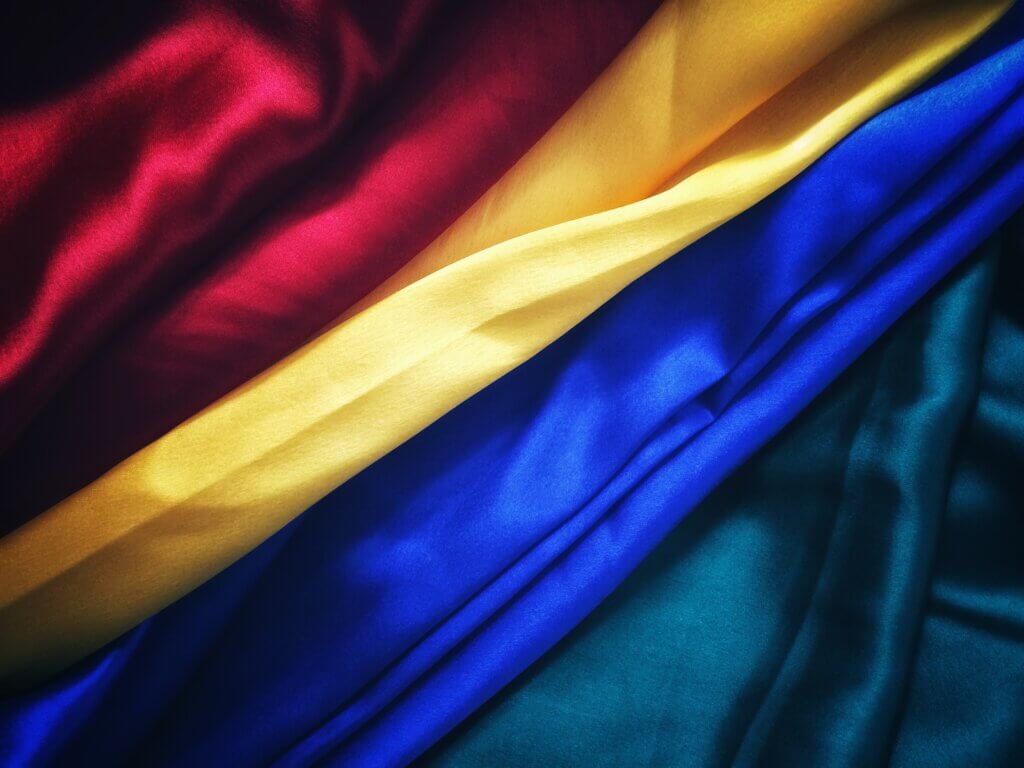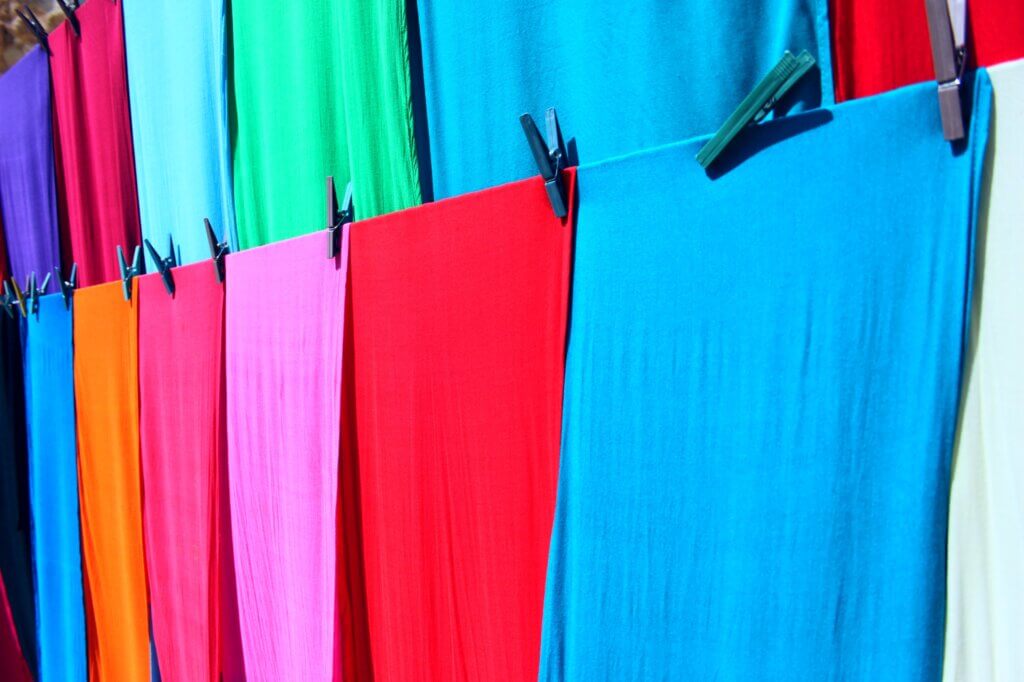Polyester, a material known for its lasting durability and persistent shape-holding traits, is widely utilized by clothing manufacturers. The inherent resistance to wear and tear and resistance to fading under sun exposure makes it an attractive choice. It is worth noting that the stability of polyester’s form is contingent on proper care, as its endurance is tested by high temperatures, which may cause deformation, melting, or shrinking due to its plastic provenance.
Interestingly, the range of flexibility seen in polyester fabric can be broad, depending on the specifics of its construction. For instance, knitted polyester, the material of which a t-shirt might be made, shows notable elasticity. On the other hand, woven polyester, often used in crafting flowing blouses, demonstrates little to no stretch. In between these extremes, woven polyester fabrics are imbued with elastic fibres: they present moderate stretchiness and are commonly used for workwear like pants.

Understanding Polyester: Fabric Characteristics and Composition
Understanding Polyester: A Durable and Affordable Fabric Choice
Constructed from petroleum-based fibres, polyester is a synthetic textile with remarkable applications. From clothing to bedding to furniture, it offers consumers an economical and durable choice. Its inherent resistance to wrinkles, shrinkage, and colour fading elevates its popularity and practicality among many available materials.
Understanding the Composition and Variety of Polyester Fabrics
Polyester is a synthetic fabric employed in various applications, constructed from petroleum-based materials that have undergone a process known as polymerization. This versatile fabric sees usage in its pure form and as blends with other synthetic and natural fibres, fabricating unique textures and weights suitable for diverse clothing designs.
In conclusion, the flexible nature of polyester blending with other materials offers fashion designers a broad spectrum of possibilities. Whether in need of lightweight summer attire or heavy-duty performance gear, it is evident that polyester can stand up to the task, making it an instrumental fabric in the textile industry.
Understanding the Stretchiness of Polyester: Woven vs Knitted Fabrics
Derived primarily from crude oil chemicals, polyester is a type of fibre – slender threads that contribute one essential component to the fabrication of textiles. However, creating fabric also depends on how we interconnect these individual fibres. Often, we use methods like knitting, weaving, or felting to fuse these fibres, forming the final material. Interestingly, this fusion process significantly influences the elasticity or stretchiness of the end product. Therefore, this configuration of threads ultimately determines whether we can deem polyester stretchy.
Understanding Stretch Properties in Woven Polyester Fabrics
Polyester, a common fabric material, is typically produced by weaving threads on a loom machine, often using the prevalent “plain weave,” wherein each line traverses above and under the adjacent line in a basic grid formation. The intrinsic trait of woven fabrics is their lack of stretchability, a feature predominant in polyester. Nonetheless, there exist notable exceptions to this rule.
A distinct exception to the non-stretch attribute of polyester is the introduction of elastic fibres into the weave. It incorporates minute tubes of rubber-like material such as elastane, lycra, or spandex, resulting in a fabric that stretches well and restores its original shape following distension. This blend of polyester and elastane is observed mainly in the production of jeggings.
The Stretchiness of Knitted Polyester Fabrics
Polyester’s inherent properties contribute to its elasticity potential, making it an ideal selection for various clothing types. The polyester fibres are intertwined within the manufacturing process to establish a cohesive framework of interconnected loops. This specific structural arrangement provides the fabric with a “mechanical stretch”, imbibing it with the flexibility and adaptability treasured in the fashion and textile industry.
Creating Non-Woven Felt from Polyester Fibres
In the arena of fabrics, polyester presents an intriguing perspective. Its intriguing malleability and resilience set it apart from other fabric materials. Due to its stretchiness, this synthetic fibre has found a lasting legacy in various applications, from fashion to domestic furnishings.
Therefore, it is evident from its production methodology and inherent attributes that polyester has a commendable amount of stretchiness and durability, making it a favoured choice among fabric connoisseurs and users.
Distinguishing between Woven and Knitted Polyester Fabrics: A Guide for Beginners
Examining the structure of a fabric can provide significant revelations about its properties. Cursory observation might reveal that the threads of the fabric exist either as rows of small loops or as a grid-like structure where lines overlap at right angles. The former indicates that the material is knitted, while the latter suggests it is woven.
Using these principles, one can discern whether specific types of polyester, like a polyester knit or a polyester weave, will feature stretch. Thus, the phenomenon of time in polyester isn’t universal – it is a quality that depends significantly on how the fabric is constructed.
Limited Stretch in Flowy, Plain-Weave Polyester Garments
Polyester is widely used in manufacturing fluid tops and dresses due to its distinct plain-weave woven construction. However, this unique fabric characteristic lacks stretchability from both left-to-right and top-to-bottom directions. Altogether, one may observe a fraction of stretch when the material is tugged along the bias grain, which signifies a diagonal direction.
However, this stretchability factor remains commonly unnoticed in ready-to-wear garments, as manufacturers largely avoid cutting along the less stable bias grain. Consequently, such clothes are unlikely to give the wearers a noticeable stretch when worn.
Polyester Chiffon: Lightweight and Non-Stretchy
Polyester is a lightweight fabric made from woven fibres renowned for its smooth texture and translucent appearance. Its inherent trait is its lack of stretchability when subjected to straight or lateral pulls. However, an exceptional characteristic of this fabric is its ability to stretch, although to a limited extent, when tugged diagonally along its bias grain. This peculiarity results in a unique form of elasticity that contributes to polyester’s versatility in various applications.

Stretchability of Polyester Georgette: An Overview
Characteristically resembling chiffon in appearance, polyester presents a thicker and less transparent alternative. Crafted as a woven fabric, it retains a robust structure that ordinarily does not allow for stretch. However, this rigid form can be manipulated under certain conditions. When pressure is applied diagonally along the fabric’s “bias grain”, it reveals an unusual malleability, exhibiting a certain stretchiness. This characteristic highlights the versatile nature of polyester, as it resists stretching under normal conditions while still being capable of such when appropriately coerced.
Understanding the Non-Stretch Nature of Polyester-Cotton Blend Fabrics
Polyester, combined with cotton fibres, results in a hybrid material often called poly-cotton. This fusion lacks the presence of elastic fibres and, therefore, inherently does not possess the ability to stretch. Garments such as office shirts and school uniforms frequently employ this type of fabric in their construction. Though all materials with a woven structure possess a certain degree of stretchiness when pulled diagonally (in the bias grain direction), this effect is generally imperceptible unless the clothing is specifically designed to be cut along this grain.
Minimal Stretchability of Crepe Polyester Fabric Explained
Crepe, a woven fabric known for its crinkled texture, exhibits only minuscule flexibility. The stretching capacity of this material extends by mere millimetres, indicating its relatively inelastic nature. Crafted through a specialized manufacturing process, the distinctive texture is generated by combining weaving and heat-setting techniques. Thus, as a fabric, crepe lacks the desirable stretchy quality often associated with other materials, such as polyester. It showcases minimal give upon manipulation, marking its robust structure and sturdy composition.
The Degree of Stretchiness in Polyester Fleece Outdoor Wear
Polyester, a dense, fluffy, and warm material, is primarily used for outdoor fleeces and jackets due to its stretchiness. The fabric’s inherent elasticity results from its knitted construction, which allows for a certain degree of stretch from one side to another. While the overall flexibility of this material can vary, polyester typically does not provide a significant level of play. Despite this, its warmth, density, and fluffiness make it an excellent choice for outdoor wear.
Enhancing Polyester’s Flexibility with Elastane for Comfortable Trousers
Polyester itself is not a stretchy material due to its woven construction. However, when combined with elastane, a form of elastic fibre, it attains a certain degree of flexibility. This elasticity makes fitted pants, often comprised of polyester fibres that contain less than 10% elastane, comfortable to move in.
Stretch Properties of Polyester Mesh in Sportswear
Polyester fabric, noted for small oval perforations, is famous for sportswear tops. This distinctive feature is not just for aesthetic appeal but also imbues the material with unique characteristics. Designed with a unique knitted construction, the fabric boasts impressive stretchability. However, this stretch is not uniformly distributed. The polyester fabric’s elasticity prominently manifests from left to right, providing a comfortable fit for diverse body types. It’s noteworthy that this stretchability does not always extend from top to bottom. Despite this, the unique blend of visual appeal and practical adaptability makes it a go-to material in the sportswear industry.
Exploring the Stretch and Recovery Properties of Polyester Jersey
Polyester jersey, owing to its knit construction, inherently possesses stretchable properties. The stretchability manifests predominantly in a left-to-right direction, making it a popular choice for garments that require an element of elasticity. Such clothing includes light to medium-weight tops and bottoms designated for loungewear, activewear, and form-fitting draped dresses.
Combining Polyester and Polyamide for Durable Activewear
When combined with polyamide, polyester gives birth to a highly robust fabric blend renowned for its strength and durability. This fusion generates an excellent material for crafting outdoor wear, such as jackets and trousers. This blend resists wear, wind, and water, making it popular for activewear. Its elasticity ensures comfort and supports diverse movements, which is essential for outdoor wear. Polyester in outdoor and activewear leverages its resilience, resistance, and elasticity.
Understanding the Stretch and Structure of Ponte Polyester Knit Fabrics

Characteristically, Ponte dresses, leggings, and loungewear garments, often marketed predominantly during winter, are produced from knit fabrics. This construction renders these materials inherently stretchable, rendering them an excellent fit for garments that are meant to be form-fitting.
To enhance the degree of stretchability and improve the recovery characteristics, attributes colloquially referred to as “bounce-back ability”, Ponte fabrics often comprise materials such as elastane, spandex, or lycra. These enhancements enable the fabric to stretch under strain and return to its original shape once the forces are removed, amplifying its suitability for fitted clothing.
Exploring the Stretch and Flexibility of Prince Polyester
Renowned for its matte finish and silky texture, Prince Polyester is a fabric with high elasticity. It stands out due to its superior flexibility and breathability, which are promising properties for a stretchable fabric. The material’s superb stretchability is heavily utilized in the production of form-fitting clothing items, including, but not limited to, activewear leggings and dancewear.
Therefore, individuals requiring a fabric that moves and flexes seamlessly with their body motions would find Prince Polyester an excellent choice. Another significant aspect of Prince Polyester that heightens its application to outdoor attire is its effectiveness against the elements. Its surface has undergone waterproof treatment and possesses inherently windproof properties, making it incredibly practical for various outdoor pursuits, adventures and gazes into the wild. All factors considered, Prince Polyester fortifies its position as a fabric that buffers functionality with style. Its exquisite stretch properties make it aesthetically alluring and a stronghold in stretchy materials.
Examining the Stretch and Resilience of Dispo Polyester
Polyester fabric has a variety of types, two of which include Dispo Polyester and dense polyurethane-impregnated fabric. While neither stretches as much as Jordan Polyester, both options are flexible. The degree of stretch may not be as copious, but it is enough to add comfort to your wardrobe.
Dense polyurethane-impregnated fabric, on the other hand, also has its strengths. This type of polyester fabric might not stretch as much as different variants, but its primary advantage is its protective features. It can repel water and dirt effectively, adding to its durability. It is a functional and practical fabric option, from keeping the wind out to safeguarding your clothes from dirt & grime.
The Stretchy and Resilient Qualities of Bonding Polyester
Bonding Polyester, frequently selected for children’s winter apparel, is an exceptional high-stretch fabric notable for its outstanding warmth and comfort attributes. Its soft texture is pleasing, while its inherent resistance to water and fading promotes durability.
The Flexibility and Durability of Trilobal Polyester
Selected for its durability and silk-like appearance, Trilobal Polyester is a desirable fabric for those seeking longevity and aesthetic appeal in their clothing. Although it does not possess the same elasticity and flexibility as other polyester variants, its unique characteristics make it a favoured choice among consumers.
Coupled with its sheen, the relative durability of Trilobal Polyester far surpasses that of more elastic or flexible polyester fabrics. This quality makes it an excellent fit for women’s and children’s clothes, designed for wear resistance and visual appeal. However, it is essential to note that despite its host of appealing features, Trilobal Polyester does not stretch as effectively as other materials, such as bonding fabrics.
Exploring the Stretch and Flexibility of Jordan Polyester for Outdoor Wear
Jordan Polyester, recognized for its waterproof and wind-resistant capabilities, is esteemed in outdoor clothing materials. This specially warp-knitted fabric offers a higher degree of stretch and flexibility and showcases impressive durability.
As waterproof and wind-resistant properties are naturally integral to outdoor apparel, Jordan Polyester’s stretch and durable characteristics make it a sought-after fabric in fashioning such garments. This material, therefore, carries an invaluable quality for those seeking comfort and durability in their outdoor clothing.
File Polyester: Resilient but Limited in Stretch for Outdoor Use
File Polyester, recognized for its splendid resistance against water, wind, and fading, has carved its niche in outdoor items. Known for its dense nature, this fabric boasts an incredible aesthetic appeal that charms viewers. Apart from its visual charm, the material possesses the highly sought-after characteristics of a waterproof and windproof textile. Quick to dry, it retains its shape effectively, contributing to its popularity.
Understanding the Stretch and Form of Memory Polyester

Memory Polyester, synonymous with its name, holds onto creases and wrinkles without the capability of reverting wholly to its original shape autonomously. This characteristic is exhibited when impacts in the form of creasing or smoothing are imposed on this fabric. Consequently, the cloth records these previous impacts, hence ‘Memory Polyester’. The fabric’s low elasticity enhances its suitability for specific garments, such as suits and blazers, which benefit from a stiffer structure. This limited elasticity equals a decreased stretch factor, rendering the material considerably less stretchy than other fabric types.
Frequently Asked Questions About Polyester Stretching
Does polyester stretch out?
Polyester, a popular fabric choice in fashion and outdoor wear, possesses a unique blend of qualities. One intriguing feature is its potential to be stretchy, depending mainly on how it has been designed and woven. A critical component that infuses elasticity into polyester is an element known as elastane, also available under various brand names.
In the absence of these polyester fabrics, elasticity changes. They can lose shape and become baggy over time. Elastane helps the material bounce back, maintaining the garment shape. While polyester can stretch, the weave and added elements mainly influence it.
Are polyester-blend fabrics stretchy?
Polyester, as a singular fabric, lacks the elasticity to stretch. However, this characteristic changes when combined with elastane, lycra, or Spandex fibres, allowing the material to try to some extent. The structure of the polyester fabric, whether knit or woven, also plays a significant role in determining its stretch factor.
Is polyester stretchy in jeans?
Typical jeans attain a certain degree of flexibility by utilizing just a slight percentage of elastane, spandex, or lycra. These components, contributing 3 to 7 per cent to the total material, transform the typically thick and slightly rigid denim into a fabric that allows for comfortable movement.
How is polyester fabric stretchy if it’s made from plastic?
In contrast to the common conception, polyester fibres inherently entail no elasticity. However, specific techniques, such as crimping or knitting in an unconventional layout, can make polyester artificially extendable. An alternative is to meld it with elastic fibres, yielding a blend material.
Is polyester flammable?
Polyester fibres have lower flammability than many fabrics. They require a more prolonged exposure to high temperatures and more heat to ignite. The ignition point is between 809.6°-910.4°F (432°-488°C). At temperatures near 428°F (220°C), polyester behaves like plastic. It rapidly melts and can drip.
Caution is vital if you come across burning polyester. The fumes from burning polyester are harmful to both humans and animals. This presents an environmental concern when considering using polyester material.
Does polyester clothing lose its shape after a while?
Incorporated widely in clothing production by manufacturers, polyester offers an immensely durable and resilient material option. If you care for garments made from 100% polyester properly, they can maintain their original shapes even after frequent washing. Manufacturers specifically choose this material for its longevity and consistent shape retention. Furthermore, clothes crafted from polyester fabric display remarkable resistance to colour degradation under sunlight, ensuring their vibrancy does not swiftly diminish.
When retailing products that contain polyester, it is advisable to furnish consumers with specific care instructions. This guidance should stress the importance of avoiding hot-temperature activities like ironing, tumble drying, or washing in hot water. Adequately informing buyers about the potential pitfalls of heat exposure will ensure the durability of their polyester items and enhance their ownership experience.
How stretchy is polyester?
The stretchiness of polyester fibre is contingent on its technique of fabrication. When we weave polyester fibre into the fabric, it usually lacks elasticity, but there are exceptions. However, when we knit the yarn, the resulting polyester fabric can stretch, ranging from a minimal 1% expansion to doubling its original size.
What can you make with polyester fibres?
Lauded for its exceptional versatility, polyester dominates the material landscape with its endless applications due to its stretchy nature. Predominantly, it finds widespread use as a fabric in the clothing industry, with a particular preference for crafting activewear owing to its unique characteristics. This synthetic material extends its utility beyond apparel, marking its indispensability across various sectors.
Is polyester breathable?
Constructed from solid plastic fibres, polyester fabrics inherently lack breathability due to plastic’s impervious nature to air. However, a specific knitting technique allows for air permeability, rendering polyester suitable for fabric use. Moreover, polyester possesses a unique trait – its capacity to repel water. Rather than being absorbed by the fabric, moisture moves around it and eventually rises to the surface to evaporate. This feature is attractive for activewear clothing brands. It ensures wearers stay comfortable and less sweaty during physical activity. While polyester isn’t naturally stretchy, it can be made so. This adaptability increases its popularity with textile producers.
How do you take care of polyester fabrics?
The care of polyester clothing items depends on the diverse ratios of blended fibres each item incorporates. Laundry instructions for pure polyester generally include washing in cold water, below 90°F or 30°C, using a detergent and fabric softener formulated explicitly for synthetic fabrics.
Caution should be taken when drying polyester clothing items, particularly with high heat that could cause the fabric to deform. Ironing is also discouraged. If quick drying is necessary, short periods in the dryer are permissible, albeit not advised for extended durations.
How Does Polyester Feel Like?
Several characteristics of 100% polyester fabric stand out, particularly its slick, seamless feel, slightly slippery texture, and well-draped lightness. However, it does not feature the breathability familiar with other materials, such as cotton. Some enthusiasts find an appealing alternative in polyester blend fabrics tailored to meet specified needs and purposes. For example, a polyester-cotton blend merges breathability with lightness – an ideal combination for those looking for such a blend. In performance and fitness items, a mix of polyester and spandex often takes precedence for its stretchy quality and comfort. These features make it a popular choice for consumers seeking material that can flexibly accommodate movement while ensuring a high comfort level.
How do you iron polyester if the clothes are crumpled?
While certain physical aspects of polyester are often praised, especially its adaptability and resilience, the topic of its stretchiness is pretty contentious. Notoriously, polyester lacks the elasticity that natural fibres are lauded for. Assuming polyester possesses a degree of stretchability could lead to mishandling of the material, especially when ironing. Applying heat to polyester necessitates a delicate balance and careful technique. For instance, ironing should only be performed at a minimal temperature, ideally through a thin cotton fabric or gauze barrier. This circumvents the direct exposure of the polyester material to the heat and helps prevent potential damage. It is also important to note that ironing might be beyond the realm of safe handling altogether with some types of polyester materials. Thus, while polyester can be a robust and versatile material, its stretchiness and response to heat are essential considerations.
Should you size up in polyester?
Polyester is a material with qualities that lend well to outdoor garments and sustainability. This versatile fabric neither shrinks nor stretches, making it ideal for pieces requiring a consistent fit. It’s interesting to note that garments made from polyester typically run true to size. Therefore, consumers seeking well-fitted clothing would not need to select a larger size when choosing polyester garments unless perhaps they desired an intentionally oversized aesthetic. Consequently, polyester’s reliable sizing contributes to its practicality in outdoor apparel and its place in sustainable fashion.
How to wash a polyester Dress?
Polyester, a commonplace material in modern fashion, possesses some exciting qualities. People commonly use it in clothing and outdoor gear because of its durability and resistance to shrinkage. Yet, many ask, “Is this material stretchy?” We can indirectly answer this by examining how we care for polyester, which might offer insight.
Often, a water temperature of around 104°F is suitable for polyester. However, it is not unheard of for some polyester fibre variants to withstand higher temperatures – approximately 140°F. This suggests that polyester is resilient. However, it also indicates that the material might warp under certain conditions. Therefore, a delicate spin cycle is advised. This helps prevent the risk of stretching the fabric.
How to hand wash polyester?
Polyester, a synthetic fibre widely used in the fashion industry, exhibits specific properties that may make it seem stretchy. However, the fact is that polyester is not innately elastic. Instead, its perceived malleability arises from the manufacturing techniques used to manipulate it, such as combining it with other, more flexible materials.


